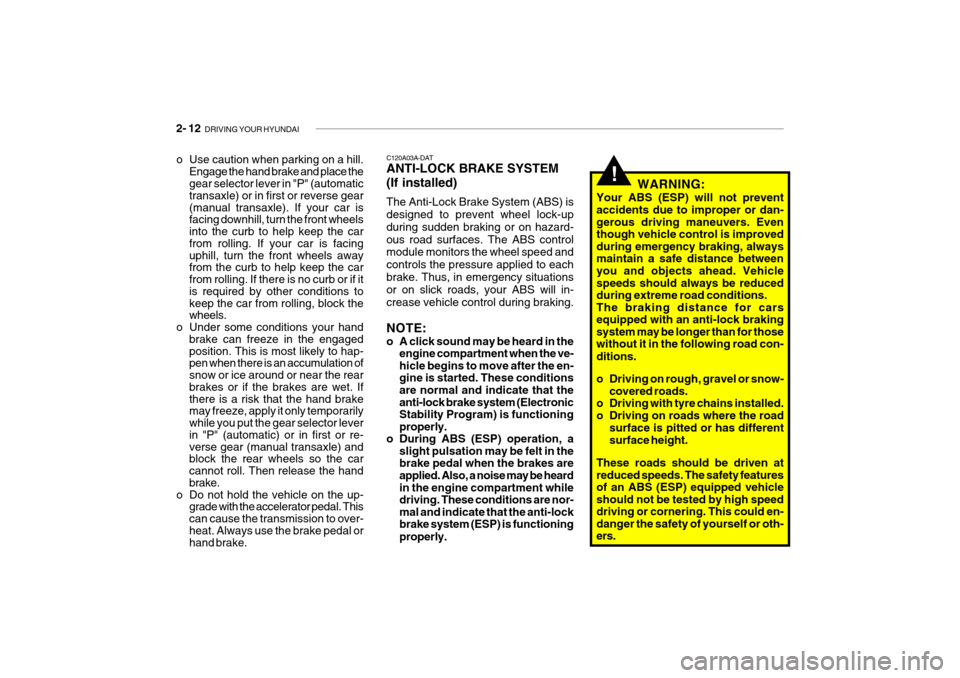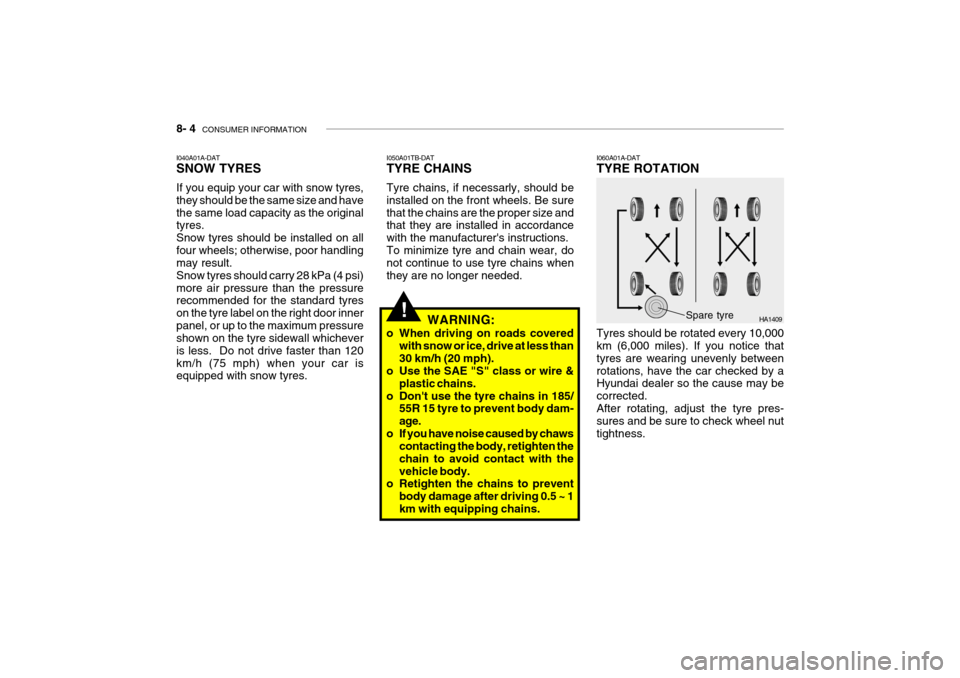2009 Hyundai Getz snow chains
[x] Cancel search: snow chainsPage 107 of 191

2- 12 DRIVING YOUR HYUNDAI
!WARNING:
Your ABS (ESP) will not prevent accidents due to improper or dan- gerous driving maneuvers. Eventhough vehicle control is improvedduring emergency braking, alwaysmaintain a safe distance betweenyou and objects ahead. Vehicle speeds should always be reduced during extreme road conditions.The braking distance for carsequipped with an anti-lock brakingsystem may be longer than for thosewithout it in the following road con- ditions.
o Driving on rough, gravel or snow- covered roads.
o Driving with tyre chains installed.
o Driving on roads where the road surface is pitted or has different surface height.
These roads should be driven at reduced speeds. The safety features of an ABS (ESP) equipped vehicleshould not be tested by high speeddriving or cornering. This could en-danger the safety of yourself or oth-ers.
C120A03A-DAT ANTI-LOCK BRAKE SYSTEM (If installed) The Anti-Lock Brake System (ABS) is designed to prevent wheel lock-up during sudden braking or on hazard-ous road surfaces. The ABS control module monitors the wheel speed and controls the pressure applied to eachbrake. Thus, in emergency situations or on slick roads, your ABS will in- crease vehicle control during braking. NOTE:
o A click sound may be heard in the
engine compartment when the ve- hicle begins to move after the en-gine is started. These conditionsare normal and indicate that the anti-lock brake system (Electronic Stability Program) is functioningproperly.
o During ABS (ESP) operation, a slight pulsation may be felt in thebrake pedal when the brakes are applied. Also, a noise may be heard in the engine compartment whiledriving. These conditions are nor-mal and indicate that the anti-lockbrake system (ESP) is functioning properly.
o Use caution when parking on a hill.
Engage the hand brake and place the gear selector lever in "P" (automatic transaxle) or in first or reverse gear (manual transaxle). If your car is facing downhill, turn the front wheels into the curb to help keep the car from rolling. If your car is facing uphill, turn the front wheels away from the curb to help keep the car from rolling. If there is no curb or if it is required by other conditions to keep the car from rolling, block the wheels.
o Under some conditions your hand brake can freeze in the engaged position. This is most likely to hap- pen when there is an accumulation of snow or ice around or near the rear brakes or if the brakes are wet. If there is a risk that the hand brake may freeze, apply it only temporarily while you put the gear selector lever in "P" (automatic) or in first or re- verse gear (manual transaxle) and block the rear wheels so the car cannot roll. Then release the hand brake.
o Do not hold the vehicle on the up- grade with the accelerator pedal. This can cause the transmission to over- heat. Always use the brake pedal or hand brake.
Page 110 of 191

DRIVING YOUR HYUNDAI 2- 15
C150A01A-AAT SMOOTH CORNERING Avoid braking or gear changing in cor- ners, especially when roads are wet. Ideally, corners should always be takenunder gentle acceleration. If you follow these suggestions, tire wear will be held to a minimum.
o Use your air conditioning sparingly.
The air conditioning system is oper-ated by engine power so your fueleconomy is reduced when you use it.
C160A01A-DAT WINTER DRIVING The more severe weather conditions of winter result in greater wear and other problems. To minimise the prob-lems of winter driving, you should fol- low these suggestions: C160B01A-DAT Snowy or Icy Conditions To drive your vehicle in deep snow, it may be necessary to use snow tyres orto install tyre chains on your tyres. If snow tyre are needed, it is necessary to select tyres equivalent in size andtype to the original equipment tires. Failure to do so may adversely affect the safety and handling of your car.Furthermore, speeding, rapid accel- eration, sudden brake applications, and sharp turns are potentially very haz-ardous practices. During deceleration, use engine brak- ing to the fullest extent. Sudden brakeapplications on snowy or icy roads may cause skids to occur. You need to keep sufficient distance between thevehicle in operation in front and your vehicle. Also, apply the brake gently. It should be noted that installing tyrechains on the tyre will provide a greater driving force, but will not prevent side skids. NOTE: Tyre chains are not legal in all states. Check state laws before fitting tyre chains.
o Keep your car clean all over. For
maximum service, your Hyundai should be kept clean and free of corrosive materials. It is especially important that mud, dirt, ice, etc. not be allowed to accumulate on the underside of the car. This extra weight can result in increased fuel con- sumption and also contribute to cor- rosion.
o Travel lightly. Don't carry unneces- sary weight in your car. Weight is an enemy of good fuel economy.
o Don't let the engine idle longer than
necessary. If you are waiting (and not in traffic), turn off your engine and restart only when you're ready to go.
o Remember, your Hyundai does not require extended warm-up. As soon as the engine is running smoothly, you can drive away. In very cold weather, however, give your engine a slightly longer warm-up period.
o Don't "labour" or "over-rev" the en- gine. Labouring is driving too slowly in too high a gear resulting in the engine bucking. If this happens to you, shift to a lower gear. Over- revving is racing the engine beyond its safe limit. This can be avoided by shifting at the recommended speeds.
Page 112 of 191

DRIVING YOUR HYUNDAI 2- 17
C160K01A-DAT Carry Emergency Equipment Depending on the severity of the weather where you drive your car, youshould carry appropriate emergency equipment. Some of the items you may want to carry include tyre chains,tow straps or chains, flashlight, emer- gency flares, sand, a shovel, jumper cables, a window scraper, gloves,ground cloth, overalls, a blanket, etc.
C160J01A-AAT Don't Let Ice and Snow Accumu- late Underneath Under some conditions, snow and ice can build up under the fenders and interfere with the steering. When driv-ing in severe winter conditions where this may happen, you should periodi- cally check underneath the car to besure the movement of the front wheels and the steering components are not obstructed.
C170A01A-DAT HIGH SPEED MOTORING Pre-Trip Inspections
1. Tyres: Adjust the tyre inflation pressures to specification. Low tyre inflation pres-sures will result in overheating and possible failure of the tyres. Avoid using worn or damaged tyres whichmay result in reduced traction or tyre failure. NOTE: Never exceed the maximum tyre inflation pressure shown on the tyres.
2. Fuel, engine coolant and engine oil: High speed travel consumes 1.5 times more fuel than urban motoring. Do notforget to check both engine coolant and engine oil.
3. Drive belt: A loose or damaged drive belt may result in overheating of the engine.
C160H01A-DAT Use Approved Anti-Freeze in WindowWasher System To keep the water in the window washer system from freezing, add an approved anti-freeze solution in accordance withinstructions on the container. Window washer anti-freeze is available from Hyundai dealers and most auto partsoutlets. Do not use engine coolant or other types of anti-freeze as these may damage the paint finish.
C160I01L-DAT Don't Let Your Hand Brake Freeze Under some conditions your hand brake can freeze in the engaged posi-tion. This is most likely to happen when there is an accumulation of snow or ice around or near the rear brakes or if thebrakes are wet. If there is a risk the hand brake may freeze, apply it only temporarily while you put the gearselector lever in "P" and block the rear wheels so the car cannot roll. Then release the hand brake.
Page 177 of 191

8. CONSUMER INFORMATION
Vehicle Identification Number (VIN) ................................................. 8-2
Engine number ................................................................................. 8-2
Recommended inflation pressures ................................................... 8-3
Snow tyres ....................................................................................... 8-4
Tyre chains ...................................................................................... 8-4
Tyre rotation ..................................................................................... 8-4
Tyre balancing .................................................................................. 8-5
Tyre traction ..................................................................................... 8-5
When to replace tyres ...................................................................... 8-5
Spare tyre and tools ......................................................................... 8-8
8
Page 180 of 191

8- 4 CONSUMER INFORMATION
!
I050A01TB-DAT TYRE CHAINS Tyre chains, if necessarly, should be installed on the front wheels. Be surethat the chains are the proper size and that they are installed in accordance with the manufacturer's instructions.To minimize tyre and chain wear, do not continue to use tyre chains when they are no longer needed.
I040A01A-DAT SNOW TYRES If you equip your car with snow tyres, they should be the same size and havethe same load capacity as the original tyres. Snow tyres should be installed on allfour wheels; otherwise, poor handling may result. Snow tyres should carry 28 kPa (4 psi)more air pressure than the pressure recommended for the standard tyres on the tyre label on the right door innerpanel, or up to the maximum pressure shown on the tyre sidewall whichever is less. Do not drive faster than 120km/h (75 mph) when your car is equipped with snow tyres. I060A01A-DAT TYRE ROTATION Tyres should be rotated every 10,000 km (6,000 miles). If you notice that tyres are wearing unevenly betweenrotations, have the car checked by a Hyundai dealer so the cause may be corrected.After rotating, adjust the tyre pres- sures and be sure to check wheel nut tightness.
HA1409Spare tyre
WARNING:
o When driving on roads covered with snow or ice, drive at less than 30 km/h (20 mph).
o Use the SAE "S" class or wire &
plastic chains.
o Don't use the tyre chains in 185/ 55R 15 tyre to prevent body dam-age.
o If you have noise caused by chaws contacting the body, retighten thechain to avoid contact with thevehicle body.
o Retighten the chains to prevent
body damage after driving 0.5 ~ 1km with equipping chains.
Page 191 of 191

INDEX 10- 5
S Seat
Front ........................................................................ 1-12
Seatback Holder ......................................................... 1-65
Seat Belts
3-Point system ........................................................ 1-20
Adjustabl e height ..................................................... 1-19
Adjusting your seat belt ........................................... 1-21
Maintenance of seat belts ....................................... 1-19
Seat pocket ................................................................ 1-66
Spectacle Ca se .......................................................... 1-58
Speedometer .............................................................. 1-42
Starting ........................................................................ 2-4
Steering Wheel Freeplay ............................................. 6-16
Steering Wheel Tilt Lever ........................................... 1-69
Stereo Sound System ................................................ 1-80
Sun Visor .................................................................... 1-68
Sunroof ....................................................................... 1-54
TTachometer ................................................................. 1-42
Tail gate ..................................................................... 1-65
Theft-Alarm system ..................................................... 1-7
Towing A trailer (or vehicle) ................................................. 2-18
Emergency .............................................................. 3-10
If your car must be towed ........................................ 3-8 Transaxle
Automatic ................................................................. 2-7
Automatic transaxle fluid checking .......................... 6-11
Manual ...................................................................... 2-5
Manual transaxle Oil checking ................................ 6-10
Trip Computer ............................................................. 1-43
Trip Odometer ............................................................. 1-42
Tyres Balancing .................................................................. 8-5
Chains ...................................................................... 8-4
Information ............................................................... 8-3
Pressure ................................................................... 8-3
Rotation .................................................................... 8-4
Snow tyres ............................................................... 8-4
Spare tyre ................................................................. 3-5 Traction ..................................................................... 8-5
Wheel and tyre changing .......................................... 3-5
V Vehicle Identification Number ..................................... 8-2
WWarning Lights ............................................................ 1-37
Windshield Wiper and Washer ....................................1-48
Windshield Wiper Blades ............................................. 6-8